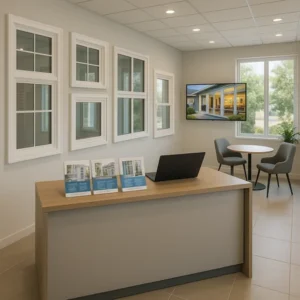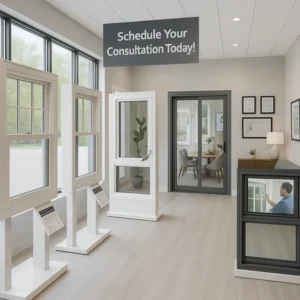Do you ever find yourself wiping away droplets of water from your windows, especially during the cooler months? Wondering why it’s happening and how to avoid it? You’re not alone! Many homeowners in Maryland and Virginia have experienced the wrath of window condensation, and it can certainly be a pesky issue to deal with. Not only does it affect the appearance of your windows, but it can also lead to mold growth and damage to your window frames. But don’t worry, I’m here to help. In this blog post, I’ll be breaking down the causes of window condensation, the signs to look out for and give you practical tips on how to avoid it in your own home. So, whether you’re dealing with the issue currently or just want to prevent it from happening in the future, this article’s for you. Let’s dive straight in.
Signs You Have a Window Condensation Problem
Let’s kick off by talking about a few of the key signs of window condensation that you should be on the lookout for:
- Water droplets or foggy areas on the surface of the glass.
- Moisture or water droplets on the window sill or surrounding frame.
- Condensation on the inside of windows that’s particularly bad in the morning.
- Mold growth or discoloration around the window frame or in the surrounding area.
- Peeling paint or bubbles in the wall surrounding the window.
If you notice these signs, it’s likely that you’re dealing with window condensation and should speak with a professional window replacement company to get it fixed ASAP.
Tips to Avoid Window Condensation
Here are a few practical tips that you can use to prevent window condensation in your home:
- Keep the humidity level in your home low: Use a dehumidifier or ventilate your home regularly to reduce humidity levels.
- Insulate your windows properly: Make sure that your windows are properly sealed and insulated to prevent drafts and keep warm air from leaking out.
- Keep your windows clean: Regularly clean your windows to prevent dirt, dust, and other debris from blocking the flow of air around the window.
- Keep window coverings closed: Keep window coverings closed at night, particularly during the colder months, to help insulate your windows and keep warm air inside.
- Keep your home’s temperature consistent: Make sure to keep your home’s temperature consistent during the day and night.
- Consider upgrading your windows. If you have older, single-paned windows, consider upgrading to double or triple-paned windows with low-E coatings or argon gas fills, which can help prevent condensation.
By following these handy tips, you can help prevent window condensation and keep your home comfortable and energy-efficient all year round.
What Exactly is Window Condensation?
Window condensation happens when warm, moist air comes into contact with a cold surface, such as a window. That’s why it typically happens during the cooler months – when warm, conditioned inside air reacts with cold window pains, the warm air cools down and loses its ability to hold onto moisture, causing the moisture to condense on the cold surface.
Now, there are two types of common window condensation: surface condensation, which forms on the surface of the glass, and interstitial condensation, which forms between the layers of a multi-paned window.
- Surface condensation: This type of condensation forms on the visible surface of the glass and is typically caused by high humidity levels inside the home combined with cold temperatures on the exterior surface of the glass. Surface condensation generally isn’t anything to worry about as it’s relatively easy to wipe away and doesn’t typically lead to any long-term damage.
- Interstitial condensation: This type of condensation forms between the layers of a multi-paned window and is caused by a failure in the seal between the layers. This type of condensation is a more serious issue because it’s not visible from the outside, and it can lead to mold growth and damage to the window frame. It generally occurs when warm, humid air inside the home leaks into the space between the panes of glass, where it condenses due to the colder temperatures between the panes. If this is left untreated, it can cause long-term damage and potentially reduce the energy efficiency of the window.
Can You Fix a Window Condensation Problem Yourself?
When it comes to fixing a window condensation problem, there are certainly some steps that you can take yourself. As mentioned before, increasing ventilation, decreasing humidity, and improving insulation are key steps to help reduce window condensation.
For increasing ventilation, you can open windows and doors, run exhaust fans, and consider installing a mechanical ventilation system to bring in the fresh air. To decrease humidity, you could use a dehumidifier or an air conditioner to keep the air in your home dry.
There are also plenty of DIY solutions you can try to help insulate your windows and reduce condensation. For example, adding weatherstripping around the window frame can create a tight seal that prevents drafts, and caulking around the window frame can prevent air leaks. Additionally, you can also purchase products such as window film, interior storm windows, and insulated drapes that can help to insulate the window and reduce condensation.
When Should I Call in a Professional to Help Fix Window Condensation?
Here are a few signs that indicate it’s time to call in a professional to help fix your window condensation issue:
- The problem persists despite your best efforts: If you have tried all the solutions mentioned above, and you still see condensation on your windows, it’s a good indication that there might be a more serious issue that requires professional attention.
- The condensation is causing damage: if the condensation is causing damage such as mold growth, rot or discoloration in your window frame, it might be a sign that you have interstitial condensation which requires a professional inspection to be fixed.
- You’re noticing drafts or leaks: If you’re feeling drafts or leaks around your windows despite being closed, it could indicate that there are air leaks in the window or surrounding frame. A professional can help you identify and fix these leaks.
- You’re looking to upgrade your windows: If your windows are old and single-paned, upgrading them to double or triple-paned windows with low-E coatings or argon gas fills can help to significantly reduce condensation. A professional can help you choose the right window type and do the installation correctly.
In general, if you’re not comfortable or confident in your ability to fix the problem yourself or have any doubts, it’s best to call in a professional to help diagnose and fix the issue. An expert can identify underlying causes and provide you with the most appropriate and effective solutions for your home.
Window Condensation – The Next Steps
Window condensation can be a frustrating issue for homeowners, but it’s important to understand the causes and take the appropriate steps to prevent it. I hope this blog post has given you a better understanding of what causes window condensation and the steps you can take to avoid it. Remember, good ventilation, humidity control, and insulation are key factors to consider. If all else fails, or the problem persists, call on the team at Windows on Washington to help!




